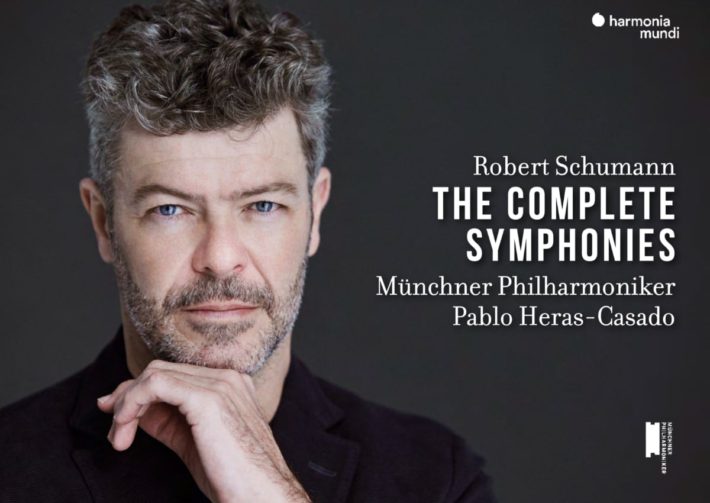Harmonia Mundi has already released recordings of Heras-Casado conducting Schumann’s cello, piano, and violin concertos with the Freiburger Barockorchester and an impressive trio of soloists. This makes the switch to the Münchner Philharmoniker and modern instruments surprising, though historically informed performance practice (HIPP) is very much in evidence. The Munich orchestra has recorded very little Schumann before, except for few concerto recordings and live performances with their legendary chief, Sergiu Celibidache.
Historically informed practice is apparent right from the opening brass fanfares of the first symphony: a firm but light tone that lacks the sonic weight heard in cycles by Karajan and Sawallisch. One also suspects the strings forces are reduced (there is no listing of players to confirm this), and throughout the cycle Heras-Casado and his players ensure the orchestration is never heavy or monochrome. The slow introduction has convincing atmosphere and the accelerando into the Allegro is excellent. String lines are clearly articulated and the balance between sections is expertly managed. But there is a motor-like quality about the playing, an incessant forward momentum that never has a moment of relaxation that proves tiring. Ticciati’s pace with the Scottish Chamber Orchestra is similar, but his phrasing has greater flexibility.
The second movement is more convincing, because Heras-Casado allows himself more room to shape the line, producing melodies of lyric beauty. But despite the beautiful sound and shaping (sample the cellos at 2’20” and the brass at 5’28”), this is essentially a dry-eyed account that skirts the emotional depth heard in the Sawallisch and Roth’s recent recording with the Gürzenich Orchestra.
The Scherzo is dispatched with brilliance and panache. String articulation is clear and uniform, and rhythms have lift and energy. In the final movement I worried Heras-Casado would revert to the driven monotony of the first movement, but he shapes this music with more freedom, making for a more convincing reading the reveals the many-hued colors of Schumann’s orchestration. The coda is especially thrilling, though the timpani are backwardly place in the sound picture.
Related Posts
- Review: Sibelius – Complete Symphonies – Klaus Mäkelä, Oslo Philharmonic
- Review: Beethoven – Complete Symphonies – Vienna Philharmonic Orchestra – Nelsons
- Review: Saint-Saëns: Complete Symphonies – Măcelaru
The slow beginning of the second symphony lacks dramatic bite, horns again backwardly placed, and the tension level is too low. Schumann wrote this symphony as he struggled to recover from an emotional breakdown, and in other performances one hears that struggle – not here. The same holds true for the faster main section: in the Recapitulation the melodic fragment that has obsessively appeared throughout the movement should threaten to overwhelm the melody, but there is no such struggle here.
The scherzo second movement is played with an impressive lightness and athleticism, a tour de force for the strings especially. Heras-Casado finds more emotional connection to this slow movement, and the final movement has plenteous power and drive, Schumann celebrating his restoration to full health.
The opening of the Rhenish is very much like the opening of the Spring symphony: forward propulsion and little rubato, with four-square phrasing. What a difference between this movement and the following slow movement, lovingly shaped with especially felicitous wind playing. Yet the music never soars as it does in Sawallisch’s classic Dresden recording, and how can that recording, now roughly five decades old, have more power and presence than this new release?
The fourth “Cathedral” movement is beautifully managed, the tempo noble and awe struck. Here Sawallisch is a bit haughty, where Dausgaard in Sweden just sounds impatient. Ticciati’s approach is like Heras-Casado, but his Munich orchestra has a depth and weight of sound that make the Scottish ensemble sound anemic. The final movement has a wonderful joy-de-vivre, the horns especially resplendent (are they more forwardly balanced than in the previous symphony?).
To me, the fourth is the real winner of this release, and it receives a splendid performance, the slow introduction operating at a higher emotional temperature, as does the playing in the slow second movement. The brass peroration that connects the third and last movements has a fulsome passion that continues right through to the final coda.
Harmonia Mundi’s recording is fine, though as noted above it lacks presence, especially compared to the Sawallisch/Dresden and Dausgaard/SCO recordings. Liner notes are short but informative, though the rhapsodic descriptions sometimes do not match the recorded performances. In short, these are fresh, scrupulously prepared, vigorous performances that lack the more consistent interpretative imagination and romantic ardor heard in the cycles by Ticciati/SCO, Gardiner/LSO, and the classic Sawallisch/Dresden, which also includes an excellent performance of the “Overture, Scherzo and Finale.”

Schumann – Complete Symphonies
Münchner Philharmoniker
Pablo Heras-Casado – Conductor
Harmonia Mundi, CD HMM90266465
Recommended Comparisons
Read more classical music reviews or visit The Classic Review Amazon store
Follow Us and Comment:
Get our periodic classical music newsletter with our recent reviews, news and beginners guides.
We respect your privacy.









